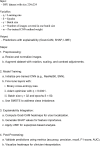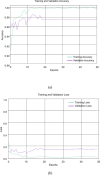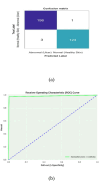A feature explainability-based deep learning technique for diabetic foot ulcer identification
- PMID: 40000748
- PMCID: PMC11862115
- DOI: 10.1038/s41598-025-90780-z
A feature explainability-based deep learning technique for diabetic foot ulcer identification
Abstract
Diabetic foot ulcers (DFUs) are a common and serious complication of diabetes, presenting as open sores or wounds on the sole. They result from impaired blood circulation and neuropathy associated with diabetes, increasing the risk of severe infections and even amputations if untreated. Early detection, effective wound care, and diabetes management are crucial to prevent and treat DFUs. Artificial intelligence (AI), particularly through deep learning, has revolutionized DFU diagnosis and treatment. This work introduces the DFU_XAI framework to enhance the interpretability of deep learning models for DFU labeling and localization, ensuring clinical relevance. The framework evaluates six advanced models-Xception, DenseNet121, ResNet50, InceptionV3, MobileNetV2, and Siamese Neural Network (SNN)-using interpretability techniques like SHAP, LIME, and Grad-CAM. Among these, the SNN model excelled with 98.76% accuracy, 99.3% precision, 97.7% recall, 98.5% F1-score, and 98.6% AUC. Grad-CAM heat maps effectively identified ulcer locations, aiding clinicians with precise and visually interpretable insights. The DFU_XAI framework integrates explainability into AI-driven healthcare, enhancing trust and usability in clinical settings. This approach addresses challenges of transparency in AI for DFU management, offering reliable and efficient solutions to this critical healthcare issue. Traditional DFU methods are labor-intensive and costly, highlighting the transformative potential of AI-driven systems.
Keywords: AI; DL; Diabetic Foot Ulcer; Heat Map; LIME.
© 2025. The Author(s).
Conflict of interest statement
Declarations. Competing interests: The authors declare no competing interests. Ethical approval: The authors declare that they have no known competing financial interests or personal relationships that could have appeared to influence the work reported in this paper.
Figures











Similar articles
-
A deep learning approach to direct immunofluorescence pattern recognition in autoimmune bullous diseases.Br J Dermatol. 2024 Jul 16;191(2):261-266. doi: 10.1093/bjd/ljae142. Br J Dermatol. 2024. PMID: 38581445
-
Multiclass skin lesion classification and localziation from dermoscopic images using a novel network-level fused deep architecture and explainable artificial intelligence.BMC Med Inform Decis Mak. 2025 Jul 1;25(1):215. doi: 10.1186/s12911-025-03051-2. BMC Med Inform Decis Mak. 2025. PMID: 40597254 Free PMC article.
-
Synergizing advanced algorithm of explainable artificial intelligence with hybrid model for enhanced brain tumor detection in healthcare.Sci Rep. 2025 Jul 1;15(1):20489. doi: 10.1038/s41598-025-07524-2. Sci Rep. 2025. PMID: 40595253 Free PMC article.
-
Psychological interventions for treating foot ulcers, and preventing their recurrence, in people with diabetes.Cochrane Database Syst Rev. 2021 Feb 8;2(2):CD012835. doi: 10.1002/14651858.CD012835.pub2. Cochrane Database Syst Rev. 2021. PMID: 35653236 Free PMC article.
-
Can thermography predict diabetic foot ulcer risk in patients with diabetes mellitus? A systematic review.J Tissue Viability. 2024 Nov;33(4):530-541. doi: 10.1016/j.jtv.2024.06.018. Epub 2024 Jun 29. J Tissue Viability. 2024. PMID: 39025743
References
-
- Rufino, J. et al. Feature Selection for an Explainability Analysis in Detection of COVID-19 Active Cases from Facebook User-Based Online Surveys. medRxiv 2023-05. (2023).
-
- Dong, H. et al. Explainable automated coding of clinical notes using hierarchical label-wise attention networks and label embedding initialisation. J. Biomed. Inform.116, 103728 (2021). - PubMed
-
- Gouverneur, P. J. Machine Learning Methods for Pain Investigation Using Physiological Signals. 6 (Logos Verlag Berlin GmbH, 2024).
-
- Ahsan, M. et al. A deep learning approach for diabetic foot ulcer classification and recognition. Information 14(1), 36. (2023).
Publication types
MeSH terms
LinkOut - more resources
Full Text Sources
Medical
Research Materials

